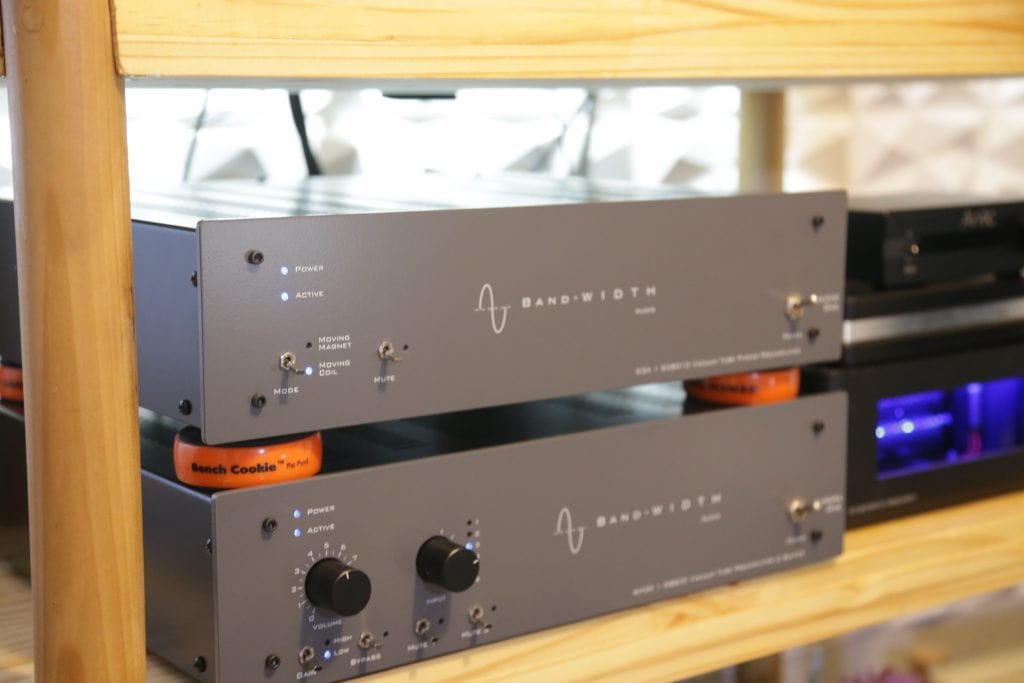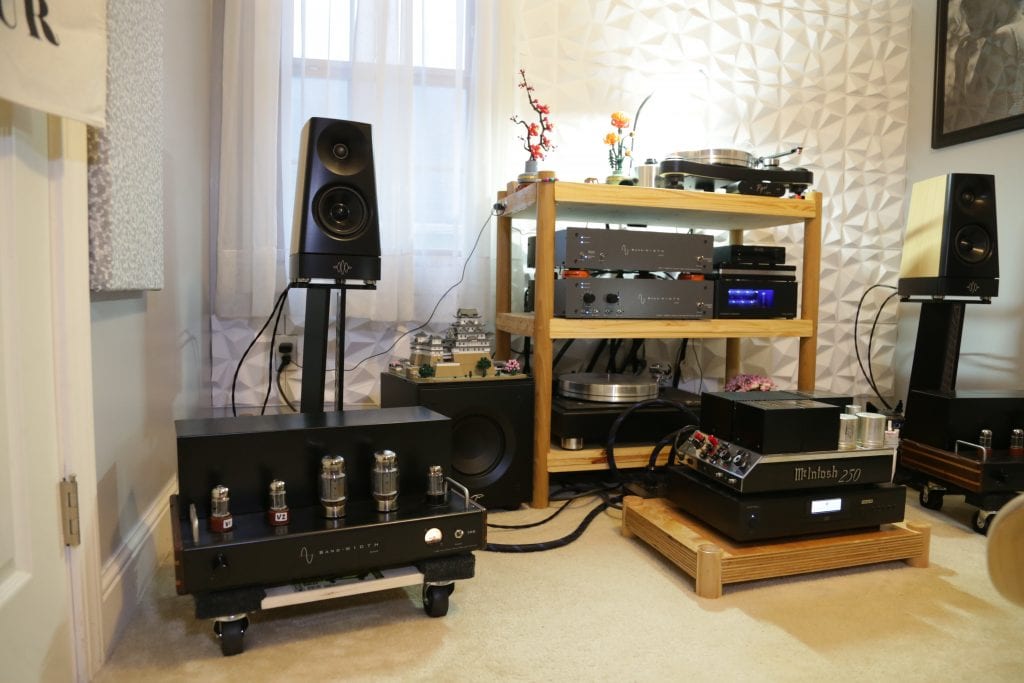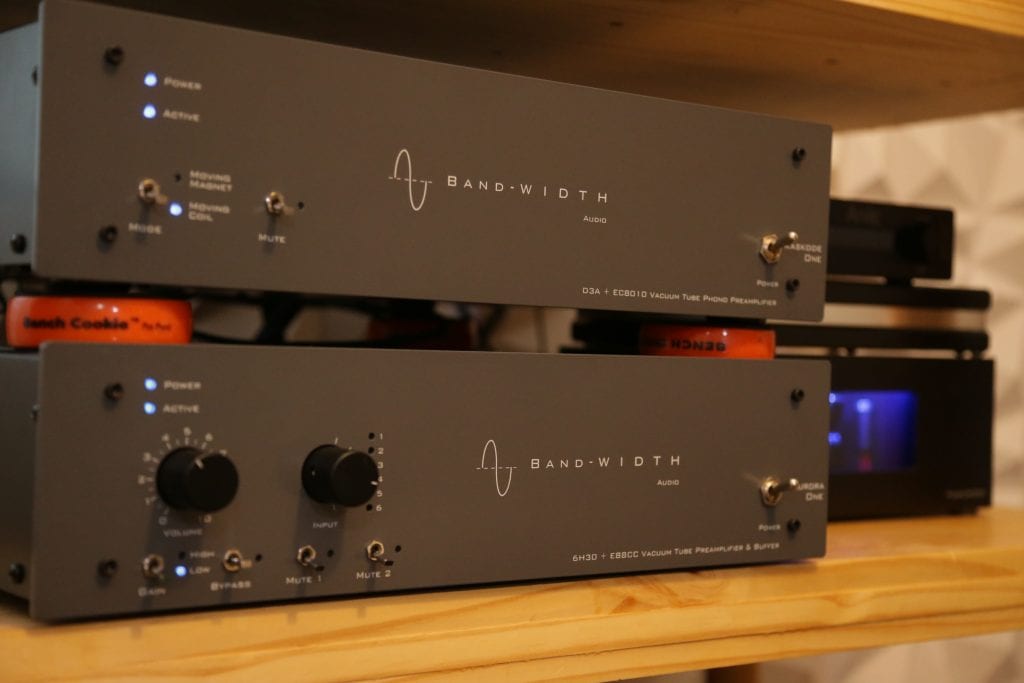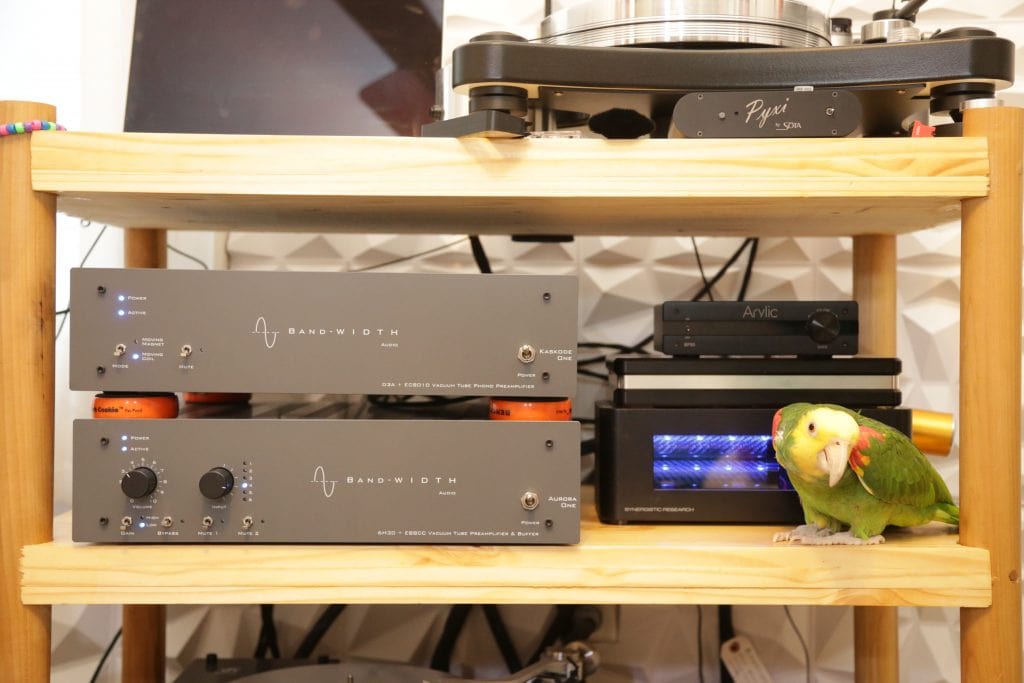If you read our last review on the Bandwidth Audio, you’ll know how I came across this wonderful Company. Mat and I connected on Instagram after coming across a photo someone shared of his setup at AXPONA this year. After doing some reading on his website, I was interested in seeing how his gear performed, so I reached out. I have for review the 288 monoblocks (review here), the Aurora One preamp, and the Kaskode One Phono amp, which is next up for review. I was blown away by the sound of the 288 amps, so I have high hopes for how the Aurora will perform on its own in my system. The Aurora comes in at a price of $4,999.00 U.S., and for that price, you get a truly purist analog preamp. On the back, you will find 6 single-ended inputs and two single-ended outputs, as well as 2 sets of dip switches to set your output type for each input. When I say purist preamp, what I mean is there are no tone controls, and you can set a zero gain, so all it is doing is sending your selected source to your amps. The Aurora One has no extra circuitry; there is no DAC or Phono, which, again, for the purists among us, is exactly how they want it. So is this purist dream a reality? Let’s listen and find out.
Aurora One Unboxing and Setup
Unboxing the Aurora One was pretty straightforward; you will find custom packing holding it firmly and safely in place. You will also find the manual, power cord, and of course, the Aurora One. Once out of the box, I got it in place in my rack and connected all my inputs and outputs. I didn’t mess with the programmable input gains as I wasn’t sure how I would want them set or if I would at all. The unit is fairly lightweight, so pulling it out later to customize your settings isn’t a big deal. On the front of the Aurora One, you will find the mute switches, gain switches, and bypass switch. The two mute switches are there as you are able to send a signal to two completely different systems, or powered subs, so you can use them as zone switches if you like, as each pair of outputs is separately buffered. The bypass switch, well, bypasses the gain switch if activated; otherwise, you have the option of high or low. I ran it on Low the whole time I had it, as it was more than enough with the power of all the amps I tried. Lastly, you have the volume and input selector, which, much like the switch, have a very satisfying feel to them.

Aurora One Sound
After listening with the Aurora and my Marantz back and forth, there are some notable differences in sound quality and tonality. Marantz products tend to lean a touch warm and musical, even being solid-state, and the Aurora one also leans a bit warm, but the timbre is different, and there are way too many variables to try to say what may be different, likely the tubes, also likely the much less cluttered curcuit could be the cause. I don’t want to say the Aurora is a traditionally warm preamp; it is closer to neutral than warm, but there is a touch that I think helps with the soul of music. It’s just enough tube influence, and if you have brighter speakers or amps, it may pull it back to a nice neutral position.
I paired the Aurora One with 3 different amps, all having differing characteristics and price points, to get as good a feel as I could for how it sounds. The first up was my MC250 from McIntosh, next was the 288 Monoblocks, and lastly my Onkyo M5140. These amps all represent very different approaches to amplifiers and all have their own pros and cons as well as sounds. They are all fairly comparable in power, which helps with comparison as the MC250 is rated for 50WPC, but often measures closer to 60WPC, the 288s are rated at 60WPC, and the M5140 is rated a little higher at 105WPC. I also paired each one with 3 different sets of speakers, so we have 9 speaker/amp combos to listen to with the Aurora 1.

With the MC250
When everything came in, I hooked up the amps first as they were going to be easier to connect than moving everything else around, so when I gave them a break to listen to the Aurora One, I hooked up the MC250 when I got the Aurora One and Kaskode One in place and hooked up. The MC250 is not the greatest amp ever made, but it will always hold a special place in my heart. When I was a teenager, I told myself I would someday own a Mac amp and a Pair of Martin Logan speakers. To me, at that time, it was the pinnacle of Hifi, and I was immediately enamoured by the design and prestige of both. Well, the Martin Logans have come and gone, but the MC250 has stayed. There have been times I have thought about selling it to fund upgrades, but I can not bring myself to do so. It has survived some 60 years with a single service last year, and I figure it will last another 60 years even if I don’t. While it isn’t the best-sounding amp I’ve ever heard, it does sound lovely. It has what many modern solid-state amps don’t have, and that is soul. It is clean, smooth, and detailed. It doesn’t have the best control over larger modern speakers, but it doesn’t get super muddy like some of the other amps of its time. It was the golden era for McIntosh, their first solid-state amp, and one that could convince the tube lovers that solid state may not be so bad.
It pairs so well with a tube preamp, and this is not the first tube preamp I have had it on. I was not terribly surprised by the synergy between the Aurora One and the MC250. I had it hooked up to my Sonus Fabers first, and the system synergy top to bottom was great. Sonus Faber tends to do extremely well with Mac gear, as they are sister companies, so again, no surprise there. I absolutely loved the inviting, smooth tone that came from the system. The word “fatigue” could be removed from the lexicon; the most velvety midrange pulled me into the music regardless of what I put on. High notes had just enough edge to be captivating and give some airiness to the weighted bass and intoxicating mids. The bass was heavy but not overpowering, and the addition of a subwoofer takes some of the weight off the amplifier, keeping the mid-bass clear.

Listening to vinyl and having a fully pure analog system from front to back was the most enjoyable way to listen to this system. That extends to listening with the YG Cairns and the LRS+. Up next was the LRS+, and of the three, this was my least favorite combination. I don’t think the synergy is quite there. The LRS played much better with the 288s than with the MC250. This is not to say they sounded poorly, but they had some stiff competition in the YG Cairn and Sonetto V, which cost 5-10 times the LRS+. They just lack the low-end I really like, and the MC250 doesn’t quite have the oomph to push them enough to fill out. I will say they have better detail and speed, and for some listeners, that is what they are after, and I know the Maggie fans love the sound for its clarity and ultra-fine detail retrieval. I find they can at times be a little too clinical, and without the low-end, it just doesn’t help the case for me.
With the YGs, it’s a completely different story. Once again, system synergy is so on point that the whole system vanishes, and you are left with pure music. Though I have to say, and I will get to this, the YGs with the 288s and Aurora One may be the best system I have heard in my space to date, and I will get to that more in the next section. With the MC250, the YGs perform excellently; they have fewer and smaller drivers, which helps keep the MC250 from being overrun. With the Aurora One, they sang so beautifully, the clean signal passage and minor gain gave the best possible input for the amp to push. Bad in, bad out, but equally, good in, good out. Having a clean preamp signal is crucial to detailed playback. The background is dark, and the space between notes is as musical as the notes themselves.

With the 288 Monoblocks
The 288s sound angelic with the Aurora One, and it makes sense. They are designed by the same person, and have a synergy that often only comes from a single ecosystem. They take the foundation that the Aurora One creates and build extremely well on it without overdoing it. Sometimes adding tube amps to a tube preamp can get too warm as they compound, but as neither the Aurora One nor the 288s are overly warm, the end result is, to my ears, the perfect amount of tube charm. The sound doesn’t get muddy; rather, it gets smoother like an aged scotch.
My favorite pairing was with the YGs, the 288s, and the Aurora One, which played to the strengths of the YGs, and the synergy was breathtaking. The level of detail and clarity would rival systems that cost much more. I couldn’t get over the realism in the music and how present the artists sounded. Everything I played was very holographic, with a sound stage that reached well beyond the room. I still get surprised by how good home audio reproduction can get. Sometimes it’s easy to get a little jaded after hearing million-dollar systems at shows or boutiques, but alas, the excitement of a good system is still there for me. There was no veil over the music; nothing sounded muffled or muted at all. Sometimes music can sound sort of flat and almost like you’re listening to it from afar, but that is not an issue here. The music was forward and engaging with great resolution.

The 288s and Aurora sounded great with the Sonus Fabers as well, as they tonally are not super different from the Cairns. They were a little softer than the Cairns and perhaps a bit warmer. If you like that vintage mid-forward easy-to-listen-to listen to warmth, then this setup is for you. There was plenty of clarity and detail, but there was less edge, which made for great, relaxed listening with no fatigue from thin or bright highs. The additional bass drivers gave a fuller, more rounded sound, but didn’t have quite the same level of top-end shine as the YGs. I think they may have leaned a bit too warm with the all-tube electronics.
Playing through the LRS+ was quite interesting as they can be thin and bright at times, especially with solid-state amps, and even more so with poorly implemented class-D. However, when playing through both a tube pre and tube power amps, they got some much-needed warmth, with a heavier mid and weightier bass response. If I were going to use the LRS+ as my main speaker, this is how it would have to be done. Even with the MC250, which is a richer solid-state amp, they just don’t have the heft I prefer. That said, with the all-tube front end, they capitalized on the clean analog signal and had incredible levels of detail retrieval, and had that soul, that richness that lends toward the life-like sound we pursue. I think with a better set of Maggies, the sound would likely be breathtaking.
With the Onkyo M5140
This is probably not a setup anyone would run, but hey, you never know what people have and what they want to upgrade first. The M5140 is a relatively inexpensive amp that will run you about 200 bucks these days. I have no Idea what the price was originally in the late 80s and can’t find much info on it. I will say it still holds up well enough today that I would have no problem recommending it to someone on a budget. I have to say it lacks the same synergy with the Aurora One that the other two had, and it is brighter than I would normally prefer. It’s also sort of flat, not in frequency but in the sound stage, it comes across very 2 demtional and it just does not do the Aurora One justice.
Hooked up the YG Cairns, it just doesn’t take full advantage of the personality and charm of the Aurora One, and makes everything seem a bit less exciting. The response is leaning brighter, not super bright, but a few notches above neutral. I will say this is certainly the best this amp has sounded, and if you have a similar amp, the Aurora One will certainly elevate it, but there are certainly limitations to that. Unfortunately, many of the 80’s solid-state amps just don’t have the same charm as their older cousins.

When I swapped in the LRS+, it started to get a bit too bright for my taste, and I personally didn’t care for the sound I was hearing. I’ll be honest, I didn’t spend a ton of time with this pairing. As for the positives, the upper clarity of the LRS+ really came through. The detail was more than adequate, and the bass was fairly good with the extra wattage. I really wish my PA-5 was up and running, as I think its better and more robust design would have been a better sampling of the era and worked better with the LRS+.
Lastly, with my Sonus Fabers is probably the way I enjoyed the M5140 with the Aurora One the most. Their warmth tamed the brightness of the Onkyo and helped return some of that dimension and texture the Aurora One provides. The low end from the 4 8″ woofers added the weight it needed to sound its best. As good as the YGs are, they just don’t have the low end that the Sonus Fabers do.
Overall
I love almost everything about the Aurora One. And to be honest, the only thing I don’t like has nothing to do with how it sounds or performs; I just wish it had a remote. The only buttons I would like on it would be volume. The Viva Solista had a remote with just an up and down arrow, and it’s perfect, as sometimes a track comes on and you just want to turn up the volume or even down if you need to. However, sonically, I love the Aurora One; it is simply a beautiful-sounding amp, and when paired with the equally wonderful 288s, it creates a performance that is worth much more than the asking price. I loved it with the YGs and my Sonus Fabers; as well, the LRS+ sounded better than they ever had before, and it really puts pressure on some of the bigger brands. It is a no-nonsense purist’s dream come true. There are no extra circuits getting in the way, no tone control, and it just steps aside and lets the music speak for itself.

I played a wide variety of music through different sources, including my Rotel CD 11, streaming Qobuz and Spotify through my MacBook, as well as the VPI Prime and Forever One through a couple of different phono stages. A song I have been streaming a alot lately is “Get By” by Ethan Regan. It is on both Qobuz and Spotify. I haven’t checked any other services, but it is well worth a listen. It’s one of those songs you just have to turn up. Genre-wise wise it would be indie/america, and has a great acoustic guitar backing the vocals, which by the way are great. The banjo really hits home the folk roots to the song as well as adds dimension to the sound stage, building on the soft bass line and balancing out the lows. The way the vocals are mastered with just a bit of echo and reverb creates this sense of a small setting. It’s one of those songs that, when you close your eyes, you are transported away from your music room. The Aurora One does the track so much justice, it delivers on detail, imaging, and sound stage in a way that makes it feel like a live performance. It is worth mentioning that if you like “Get By” there is a good chance you will like “Ordinary” by Alex Warren, which is composed in a similar way but with a more dramatic tone, and builds to a much larger crescendo. It is another song that just highlighted everything I love about the Aurora One.

Pros and Cons
Pros:
- Good build quality again
- Great sound quality
- Just warm enough
- Purist Design
- Complete bypass option
- Gain options
- Plenty of Inputs
- 2 pairs of outputs
- Clean Design
- Satisfying knob and switch feel
Cons:
- would like a remote for volume, but not a deal breaker
Features and Specs
Features
- SHIPS WITH 6H30PI AND E88CC GOLD PIN TUBES
- 6 PAIRS OF RCA INPUTS
- 2 PAIRS OF RCA OUTPUTS
- INDEPENDENTLY BUFFERED
- INDEPENDENT MUTE CONTROLS
- HIGH GAIN, LOW GAIN, AND BYPASS MODES
- PRE-PROGRAMMABLE FOR EACH INPUT
- ALPS BLUE VELVET VOLUME CONTROL
- DUAL MONO REGULATED POWER AND FILAMENT SUPPLIES
- TIME DELAY OUTPUT ACTIVE CIRCUIT FOR POP-FREE STARTUP AND SHUTDOWN
- CUSTOM-DESIGNED LOW FLUX DENSITY EI TRANSFORMER
- PRP PRP9372 US-MADE METAL FILM NON-MAGNETIC AUDIO GRADE RESISTORS
- SOLEN FAST COUPLING CAPACITORS
- MOGAMI W2330 COAXIAL SHIELDED AUDIO SIGNAL WIRING
- EXTRA THICK FR4 PRINTED CIRCUIT BOARDS
- ALUMINUM CHASSIS WITH STEEL DIVIDER FOR LOWEST NOISE
- SORBOTHANE® FEET FOR VIBRATION ISOLATION
Specs:
- Gain
- 14dB (High Gain)
- 8dB (Low Gain)
- 0dB (Bypass)
- Channel Balance (With Volume knob set to -6dB)
- 0.01dB (High Gain)
- 0.01dB (Low Gain)
- 0.2dB (Bypass
- THD +N (1V RMS Output)
- 0.03% (High Gain)
- 0.06% (Low Gain)
- 0.01% (Bypass)
- THD +N (2V RMS Output)
- 0.05% (High Gain)
- 0.08% (Low Gain)
- 0.01% (Bypass)
- Frequency Response (-3dB down)
- <10Hz and above 175KHz
- Input Referred Noise (A-weighted)
- 1.9uV / -112.2dBu (High Gain)
- 3.5uV / -106.9dBu (Low Gain)
- 8.1uV / -99.6dBu (Bypass)
- SNR 2V RMS Output (A-weighted)
- 106dB (High Gain)
- 107dB (Low Gain)
- 108dB (Bypass)
- Rated Output
- 10V at 0.5% THD+N
Specs Cont:
- Input Impedance
- 50KΩ
- Recommended Load (Output)
- 10KΩ or greater
- Tubes (Tested and Matched in House
- 2x 6H30PI Electro-Harmonix Gold Pin
- 2x E88CC JJ Gold Pin
- Voltage
- Available in 115-120VAC or 230-240VAC
- Power Consumption
- 70 Watts
- Dimensions (includes faceplate and feet)
- 17.5″ x 14.25″ x 4.5″
Price: $4,999.99

Associated Equipment
- Marantz SR7009 Preamp
- Bandwidth Kaskode 1 Phono amp
- VPI Avenger Phono
- VPI Prime with 10″ Unipivot arm on VTA base with Ortofon Quintet Red and Shyla Cartridges
- Rotel CD-11
- MacBook Pro with iFi Go Link Max
- Sonus Faber Sonetto V
- YG Cairn
- Magneplanar LRS+
- Paradigm Defiance V8 Sub
- Bandwidth Audio 288 Monoblocks
- Mcintosh MC 250
- Onkyo M5140
- Synergistic Research Powercell 8 SX
- Synergistic Research Foundation SX cabling
- Viborg Power Cables to the amps only (not enough SR on hand)
Conclusion
The Aurora One is a great Pre-amp, and for someone who wants a pure analog pre-amp, it may be the perfect fit. You get 6 analog (single-ended) inputs and 2 outputs, which you can mute independently, meaning you use this for two separate systems or power a subwoofer, perhaps 2 more power amps for bi-amping. There are no tone controls, so if you are the type to tinker with tone, you will need an external EQ. You do have gain options and can set the bypass on a per-input basis on the back of the Aurora One. You can also use the master switch on the front to turn it to low/high or bypass, depending on what you prefer. The volume and input selector knobs are both very tactile, and speaking of the volume knb, it is super smooth. I also really like how much you have to turn the knob for volume change, sometimes they can be very quick, making small adjuments hard, but the Aurora One takes a bit more of a turn making finding that perfect level easy. Sound quality is excellent, the signal is extremely clean, making detail retrieval a breeze. The tubes provide just enough warmth and soul; it isn’t overdone, and with the Bandwidth 288s, it is perfect. At 5 grand, it is honestly a bargain, and could easily compete with preamps double its price. Close cost-wise is the Prima-Luna Evo400, which has similar connectivity, actually costs a grand more, and I prefer the Aurora One. If you are looking for a preamp that is true ot the music, the Aurora One needs to be on your list to audition.
For more Info and how to buy, click the link below:













Disclaimer: Bandwidth Audio supplied Hifi Chicken with a demo Aurora One for the purpose of this review. Bandwidth Audio nor any affiliate paid in part or in full in exchange for this review.
One thought on “(Review) Bandwidth Audio Aurora One Preamp – A Purist’s Perfect Preamp”